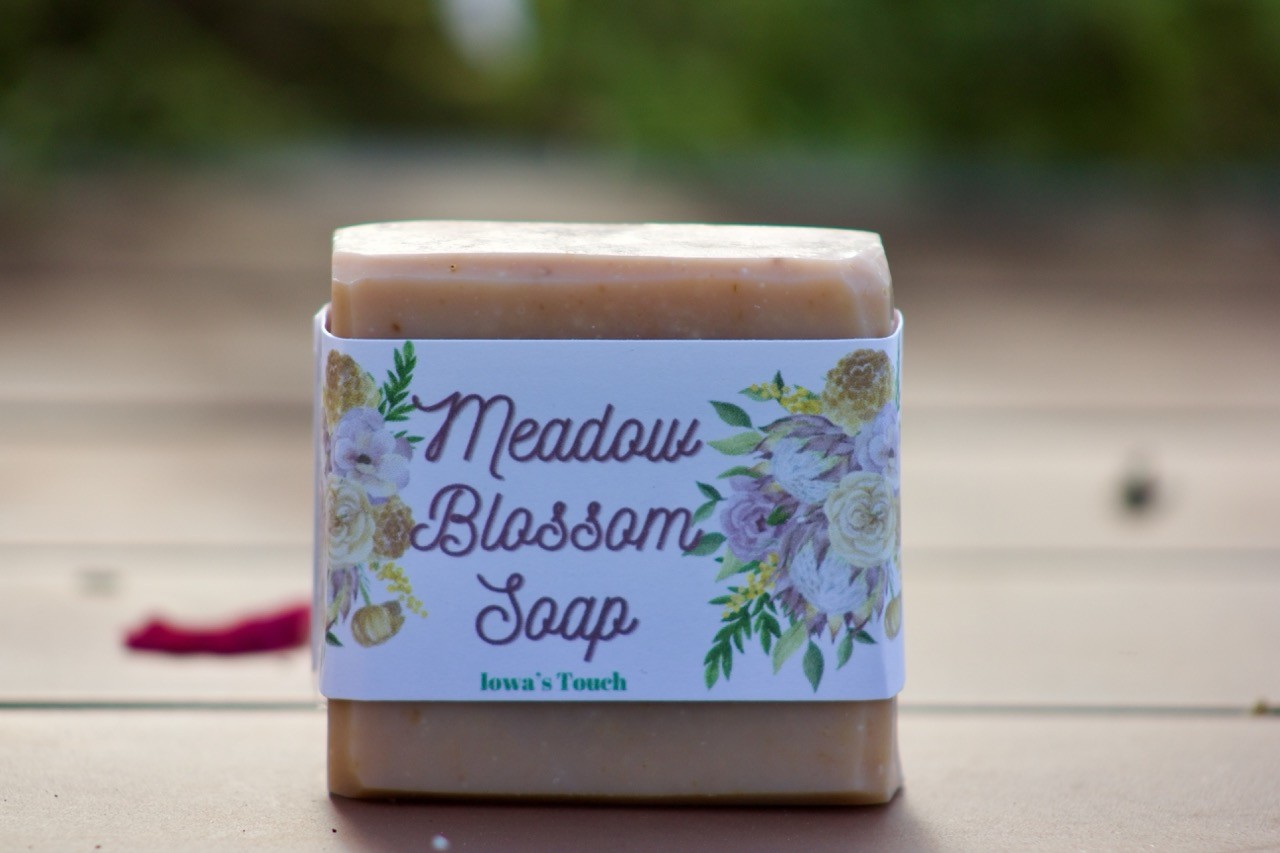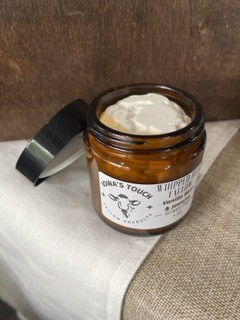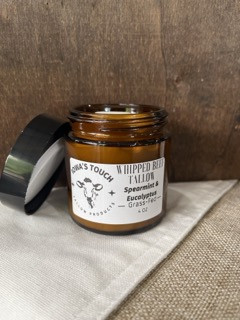Come visit us in person and shop our STORE - the Iowa Meat Shack!
At 322 West Main St. in West Branch: open 4 to 6 on Tuesday-Friday and 9 to 1 on Sat.
Our lamb and beef dine on a veritable salad bar from start to finish. Our pork and poultry are raised on pasture.
The piggies root around in the ground - no cement in their lives.
The chickens' portable pens are moved almost daily to fresh grass where they find new delicious bugs.
Their plant and bug forage is supplemented with non-GMO grains.
No antibiotics or hormones are used. And the animals are tended to daily with experienced, loving care.
What We Offer
THE STORE IN WEST BRANCH is now OPEN! Selling our grass-fed and pastured beef, lamb, pork and poultry. Iowa's Touch Skin Care with options of Whipped Beef Tallow Balm, Tallow Bar Soap! and so much more! AND, pizza, ice cream, eggs, flowers, herbs, cheese curbs and more dairy!
Our summer hours are: TUESDAY 4-6 WEDNESDAY 4-6 FRIDAY 4-6 SATURDAY 9-1 and our address is 322 East Main Street, West Branch.

Iowa's Touch Skin Care Products
Skin care products made from our Grass- fed/ Finished Beef tallow made by Jaydon & Addie. Shop online or Available at the Iowa Meat Shack.
What our customers say about our grass-fed, pastured meat...
I just wanted to let you know that we are absolutely thrilled with the taste & quality of the beef we purchased from you guys. We’ve been buying (or raising ourselves!) grass fed beef for 12 years and both my husband and I think your beef is at the top! We are very thankful to have a freezer full of nutrient dense & delicious beef to feed our family!
Working with Jaimie of Twisted Oaks Meats makes it EASY to source the best quality grass-fed products that are not only delicious, but really amazing value when purchasing in bulk. There is no excuse for any local food operation to not hop on board this chuck wagon!
 Kyle Sieck, owner of Local Burrito
Kyle Sieck, owner of Local Burrito
The meat is AMAZING. We enjoyed the chicken for Thanksgiving and it was a perfect roast. We also hadn't had pork for SO long (poor options in a farming state, of course), so all of those brats (and bacon, and soon bacon in brats!) are making us VERY happy.
Eating grass-fed meat is so important, it's the key to overcoming my client's health challangers. I like to give out gift certificates to Twisted Oaks Meats.
 Rachel Headings, Functional Medicine Practioner in Iowa City
Rachel Headings, Functional Medicine Practioner in Iowa City
Thanks for the fun emails, I do always enjoy reading what you are up to on the farm. I bought 10+ pounds of your beef several weeks ago and it has been delicious!
Four families bought a whole cow and a whole hog last May. We all enjoyed it. The ground is amazing, very lean. We've already purchased more.
Is the nutritional content of grass-fed beef different than grain-fed?
There are a lot of studies showing a significant difference between grass-fed and grain-fed beef.
Grass-fed animals have a different muscle composition than grain-fed animals. “The difference is mostly in the type and amount of fatty acids," says Artemis P. Simopoulos, MD, FACN, an endocrinologist; founder and president of the Center for Genetics, Nutrition and Health; and author of The Omega Diet.
"For example, animals in the wild that eat grass have more meat, less fat, less saturated fat, and more polyunsaturated fatty acids. And they have, particularly, a higher amount of omega-3 fatty acids.”
But as animals were given grain, starting in the mid 20th century, due to the introduction of large-scale livestock operations that relied on feedlots and grain feed, the nutritional quality of the animals started to change.
The grain feed increases the levels of omega-6 fatty acids and reduces the level of omega-3 fatty acids in the animals.
This change has devastating consequences for people who eat these animals.
When there is an imbalance of omega 6 fatty acids in your diet, the result is inflammation, weight gain, diabetes, heart disease, dementia, and emotional issues.
Many scientists are certain that this single shift in the American diet - from consuming healthy fat to unhealthy fat, has a greater effect on weight and health than total caloric or fat intake. *https://www.todaysdietitian.com/newarchives/1115p26.shtml
Why is grass-fed beef special? I thought all cows ate grass?
When you drive around here in Iowa, you see all these cows in fields. So you assume that those are the cows that you're eating, and from a distance, it sure seems to you that they are eating grass.
Well, if you took a closer look, you'll usually see that somewhere on the property, near a barm is a grain bin, that constantly dispenses large amounts of grain to the animals, and that is their primary food source.
When cows are born, they need to stay with their mother and nurse until their body can digest grains. THEN, they are sold off to large-scale feedlots out west in Colorado, Texas or Kansas, where they will be held in a dirt lot for the next 6-9 months and fed enormous amounts of grain by-products and growth-inducing antibiotics.
Feeding them grains and restricting their movement ensures the fattest possible animal as fast as possible. Which is good for no one or no one - except one thing - the profits for the big company that's 'growing' this meat.
It's not good quality meat. It creates terrible damage to the environment. It uses a lot of fossil fuels to raise and then ship around the country. But it can be sold for less than grass-fed, so people will buy it.
Very few of the cows you'll see standing around on an Iowa field are grass-fed. Grass-feeding an animal is not as simple as sticking them out on a pasture and leaving them there.
You have to do something called rotational grazing, in which you section off your pasture into small segments, and move the animals in and out of there fast (usually a day), in order to have them graze just the right amount of time to get the most from the grass, without destroying the pasture.
It's called intensive grazing, and it's the key to creating healthy soil that grows an amazing salad bar of grass and forage that grows healthy animals.
Is grass-fed an official term?
What are the legal requirements to be considered grass-fed?
American Grassfed Association helped the USDA develop an official definition in 2006.
However, in 2016 the USDA dropped its official definition of grass-fed, saying they didn’t have the authority to define whether “specific grassfed claims that companies make on their packaging are truthful and not misleading.”
HUH! Really? Since most of the meat eaten in this country is produced by just a few huge players, it should be pretty easy. But those big players are the ones who lobbied the USDA to make this change. It allows them to use the “free-range, grass-fed, natural” labels, without really being any of those things.
So, no - the government no longer has an official definition of the term grass-fed, which means it’s open to “interpretation.”
Furthermore, no stipulations existed within the USDA's grassfed labeling program regarding the use of antibiotics, growth hormones, or GMOs in the animal feed. If you do all those things too, then you get to be labeled ‘organic’. That’s how some grass-fed meat producers can claim ‘free range and grassfed’ but cannot get away with calling themselves organic, as that does have official guidelines.
What’s our definition of grass-fed?
We like the original definition of grass-fed that the American Grassfed Association defined back in 2006.
It says: that ruminants must be fed only grass and forage (which are herbs other than grass) and cereal grains in their vegetative, pregrain states, and have continuous access to pasture during the growing season.
It also says they can't be fed grains, such as wheat and corn, or their byproducts.
If big meat producers still had to follow those guidelines, they wouldn’t be able to label themselves organic or free-range or Grassfed.
I have found only one grass-fed label in big Iowa area grocery stores that I know is truly trying to be grass-fed - Thousand Hills.
That company has approached us at Twisted Oaks and asked to buy our meat so they can put their label on it. (That's what they do, they buy from farms like ours.)
While we appreciate that they recognize the value of our meat and it meets their standard of grass-fed, we prefer to sell directly to you, the consumer.
We feel like our standards, the quality of our animals, and how we butcher and process them, surpass even other small grass-fed farmers.
We want to be able to tell you that what you're eating is all ours, and we watched it grow every day of its life and supported it properly so it's the best possible meat you could eat.
How do you cook grassfed beef steak and roasts, and pastured pork cuts?
Grass-fed beef and pastured pork, chicken and lamb does cook up differently. SO YOU MUST DO THESE THINGS to ensure it’s tender and juicy!
Just thawing to the point where it's not frozen is not thawed enough!
The raw meat must not be cool to the touch.
Leave it out on the counter for at least a few hours before you cook it. Please don’t worry about bacteria growing. That only happens fast and dangerously after you cook the meat.
Putting cold meat on heat makes the fibers seize up tightly, ensuring tough meat.
High heat only for 30 seconds each side to sear, then get your temperature way down, or better yet, remove the steak from the heat and cover to finish cooking with steam. Let that happen for 5 minutes. Then let the meat cool on the plate for another 5 minutes.
If you are cooking a roast or stew meat, the key is low low low, and slow slow slow.
Equally important, ADD SOME FAT: a huge pat of butter or lard on top, or coconut oil or olive oil.
The key to lightening and brightening a slow-roasted-in-fat piece of meat is a squeezed orange and half a cup of apple cider vinegar.
How will you know when a grass-fed beef or pastured pork roast is done?
It will pull apart easily.
Since grassfed beef cooks faster and at lower temperatures than grain-fed beef (because it has less external fat to insulate the meat during the cooking process), subtract 10 to 20 degrees F for the meat doneness temperature!
How does grass-fed beef and pastured meat heal the planet?
Clean meat and a clean planet go together!
Animals raised in confinement get sick easily so they need lots of antibiotics to survive.
Those antibiotics get into their flesh and the water supply.
Tilling the soil to raise grains to feed animals destroys the topsoil, releases carbon into the air, and requires at least 40 million pounds a year of chemicals - all of which end up in the meat and the water supply.
The huge machines and fuel required to raise this grain and transport it - are wildly energy-inefficient and polluting.
Pasture is not only green and beautiful: it also sucks carbon from the atmosphere, reducing global warming.
Animals roaming on pasture improve the health of the soil tremendously with their manure and plant pruning, making the plants grow better, and thus creating a mutually beneficial cycle between earth and animal.
Thick pasture and healthy soil create a great diversity of plants and animals, which reduces the chances of swarms of invasive species and insects, reducing drastically the need for pesticides and herbicides.
New to Grassfed? Which grass-fed beef cuts are easiest to love?
If you’ve never tasted grass-fed beef before and want to be sure your family will like it, here’s some advice.
Cook it in lots of butter and put ketchup on it. I’m only kind of kidding.
If you’re making a steak or frying up a hamburger, grass fed cooks quicker even at lower temps, and is naturally lean, so you need to add in some butter.
Most people cover their hamburgers in condiments, or put sauce on their meat for tacos, or tomato sauces on their meat sauce for spaghetti, so for sure - ground hamburger is definitely the way timid first-timers should start their grass-fed switch.
In fact, grass-fed steaks should be tried last, as that’s where your meat will have the least adornments, so the taste of the meat itself is the primary flavor.
After ground beef, the next cuts to try are the roasts - like a chuck roast.
Those you can slow cook in the crockpot with all your condiments, onions, garlic, butter, ketchup, mustard, Worchester, balsamic vinegar, making the overall taste so familiar, any slight variation in the meat flavor itself will not be noticed.
Our grass-fed beef spends their lives dining on a veritable salad bar of 30 different wild grasses, clovers, flowers, etc. So all of that absolutely affects the flavor of the meat. It’s meat as it SHOULD be.
But if you’re only used to eating beef that’s eaten grains, grass fed will taste slightly different to you. What you’re tasting, actually, is vitamins and minerals. It’s a good thing. Make the switch as fast as possible! Soon grassfed will be your new normal.
Can I get fresh grassfed beef in Iowa?
Yes, BUT, frozen IS fresher!
Unless you are there shortly after the animal is butchered and can walk away with your grassfed meat right then and there, you want it to be frozen.
If you’re getting defrosted grassfed (or any meat for that matter) beef or pastured pork or free-range chicken in the store, that does not mean it’s fresh!
Rather, chances are 99% that the store got it frozen, so they defrosted it. And once meat is defrosted, it has just a few days before it begins to oxidize and bacteria break it down.
That’s why most companies who sell meat, spray the meat with chemicals that preserve it, and try to keep it from developing a brown color and funny smell.
And then once you get it home, maybe it’s another few days before you use it. So the meat’s been defrosted for up to a week or more.
Avoid all that. Just get frozen, grass-fed meat direct from your local farmer. The fewer folks between you and your meat, the better it is.














